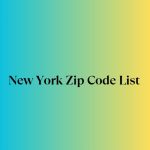Introduction
Durham, North Carolina, is a city brimming with history, culture, and modern amenities. As one of the key cities in the Research Triangle, it’s a hub for education, healthcare, and innovation. But beyond its renowned institutions and bustling downtown, understanding the nuances of Durham’s zip codes can offer deeper insights into its unique neighborhoods and communities. Whether you’re planning to move to Durham, start a business, or just explore, knowing about its zip codes can help you navigate the city more effectively.
What is a Zip Code?
Zip codes are more than just numbers at the end of an address; they are essential tools for organizing mail delivery, demarcating geographical boundaries, and even influencing economic and social policies. The United States Postal Service introduced zip codes in 1963 to improve mail delivery efficiency. Each zip code typically includes five digits, where the first digit represents a group of U.S. states, the next two digits designate a region or a large city within that group, and the final two digits identify specific post offices or postal zones.
Durham: A Brief History
Durham’s history dates back to the early 19th century when it was primarily an agricultural area. The city saw significant growth with the establishment of the tobacco industry, particularly through the American Tobacco Company. The arrival of the railroad in the late 1800s further spurred its development. Over the years, Durham transitioned from an industrial town to a center of education and healthcare, largely thanks to Duke University and the Research Triangle Park.
The Geography of Durham
Durham is located in the central part of North Carolina, covering approximately 108 square miles. It’s part of the Research Triangle area, along with Raleigh and Chapel Hill. The city boasts a mix of urban, suburban, and rural areas, each offering unique living experiences. Neighborhoods like Downtown Durham, Southpoint, and North Durham each have distinct characteristics, from vibrant city life to quiet, residential tranquility.
Durham Zip Code Overview
Durham comprises several zip codes, each representing different areas of the city:
- 27701: Covers the downtown area, known for its vibrant city life and historical sites.
- 27703: Encompasses East Durham, a rapidly developing area with a mix of residential and commercial properties.
- 27705: Includes the Duke University campus and surrounding neighborhoods.
- 27707: Covers South Durham, known for its shopping centers and suburban neighborhoods.
- 27713: Features the Southpoint area, with a major shopping mall and a mix of housing options.
Each zip code in Durham offers something unique, from bustling urban environments to serene suburban settings.
Demographics of Durham
Durham is a diverse city with a population of over 280,000 people. The city’s demographics reflect a rich tapestry of cultures and backgrounds. Approximately 50% of the population is African American, 40% White, and the remainder includes Hispanic, Asian, and other ethnic groups. This diversity is a cornerstone of Durham’s vibrant community life, influencing everything from local cuisine to cultural festivals.
Economy and Employment
Durham’s economy is robust and diverse. Major industries include education, healthcare, and technology. Duke University and Duke Health are the largest employers, followed by companies in Research Triangle Park such as IBM, Cisco, and GlaxoSmithKline. The job market is thriving, offering opportunities in various sectors, from biotech to finance.
Education in Durham
Education is a significant aspect of life in Durham, home to prestigious institutions like Duke University and North Carolina Central University. The Durham Public Schools system serves the area with numerous elementary, middle, and high schools. The city’s emphasis on education is evident in its numerous public libraries, educational programs, and community learning centers.
Healthcare Facilities
Durham is often referred to as the “City of Medicine” due to its excellent healthcare facilities. Major hospitals include Duke University Hospital and Durham Regional Hospital. These institutions provide top-notch medical care and are involved in groundbreaking medical research. Additionally, numerous clinics and specialty healthcare providers ensure residents have access to comprehensive health services.
Recreation and Entertainment
When it comes to recreation and entertainment, Durham offers something for everyone. The city is dotted with parks such as Eno River State Park and Duke Forest, ideal for hiking, picnicking, and outdoor activities. The Durham Performing Arts Center (DPAC) hosts a variety of shows, from Broadway productions to concerts. Festivals like the American Dance Festival and Full Frame Documentary Film Festival add to the city’s rich cultural tapestry.
Dining and Shopping
Durham’s dining scene is as diverse as its population. From high-end restaurants to food trucks, there’s no shortage of culinary delights. Notable dining spots include Mateo Bar de Tapas, Pizzeria Toro, and Dame’s Chicken & Waffles. For shopping enthusiasts, The Streets at Southpoint offers a mix of upscale shops and popular retail chains, while local boutiques and markets provide unique finds.
Real Estate and Housing
The real estate market in Durham is dynamic, with options ranging from historic homes in neighborhoods like Trinity Park to modern apartments downtown. Housing prices have been on the rise, reflecting the city’s growing popularity. Whether you’re looking for a quaint bungalow or a spacious family home, Durham’s real estate market caters to a variety of preferences and budgets.
Transportation in Durham
Getting around Durham is convenient, thanks to a range of transportation options. The Durham Area Transit Authority (DATA) provides bus services throughout the city. For those commuting to nearby areas, the GoTriangle bus service connects Durham with Raleigh, Chapel Hill, and other parts of the Triangle. Major highways such as I-85 and I-40 facilitate easy access by car, while the Amtrak station offers rail services to various destinations.
Crime and Safety
Like any city, Durham faces challenges with crime, but concerted efforts are in place to maintain safety. The Durham Police Department actively engages with the community through initiatives like neighborhood watch programs and youth outreach. Recent statistics show a trend towards decreasing crime rates, thanks to these comprehensive safety measures.
Conclusion
Durham is a city of contrasts and diversity, where historical charm meets modern innovation. Each zip code tells a different story, contributing to the city’s rich tapestry. Whether you’re a potential resident, a business owner, or just curious, understanding Durham’s zip codes provides a deeper appreciation of what this vibrant city has to offer. From education and healthcare to dining and entertainment, Durham is a place where you can truly live, work, and play.
FAQs
What is the largest zip code in Durham?
The largest zip code in Durham by area is 27703, covering East Durham and extending into more suburban and rural regions.
How do I find the zip code for a specific address in Durham?
You can find the zip code for a specific address in Durham by using the USPS zip code lookup tool available on their website.
Are there any zip codes in Durham with higher crime rates?
Crime rates can vary by neighborhood within each zip code. It’s advisable to check local crime maps and statistics for detailed information on specific areas.
Which Durham zip code is the best for families?
Zip code 27713, covering the Southpoint area, is often considered family-friendly due to its good schools, parks, and suburban atmosphere.
How has Durham’s zip code map changed over the years?
Durham’s zip code map has evolved with the city’s growth and development, adjusting to accommodate new residential and commercial areas.










